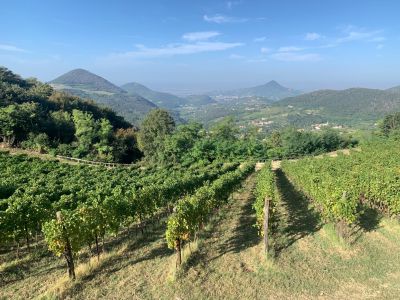La scrittrice Myra Robinson ha da 20 anni un appartamento in Veneto. Purtroppo, deve metterlo in vendita. Ha deciso di assumere un artista per dipingere le viste e il terreno vicino all'appartamento. L'artista, Julian Vilarrubi, è andata a casa sua e ha trascorso del tempo con la signora per comprendere la sua vita ed i luoghi più importanti. Dipingerà per lei quello che ha visto in acquerello. Anche se i primi schizzi non erano né colorati né completi, Vilarrubi ha spiegato che erano solo sue idee. La signora Robinson attende di vedere i dipinti che saranno i ricordi più belli della sua vita in Veneto.
Who would have thought? The decision that changed my life 20 years ago, to buy a second home in Italy, has now reached a turning point. It is time to take stock. A second floor apartment with a wonderful view is no longer quite the asset it once was. The stairs are becoming hard work, but we have so many memories locked into the place that selling will be painful.
Happy memories are important, but a tangible memory would be even better. What better than commissioning a painting of a favorite view? Of course, this is hardly an original thought. Artists from the Renaissance onwards were often commissioned to produce masterpieces. Mr. and Mrs. Andrews commissioned Gainsborough in the 18th century to paint them in their own landscape, whereas my painting will be of a view I claim as my own simply through sentimental attachment. I am not placing myself in the category of wealthy patrons, but I like to think I am following a tradition.
How could I find an artist? I remembered Julian Vilarrubi, a tutor many years ago on a painting course in Tuscany which I helped to organize. He was then the typical impoverished artist, newly graduated and teaching for a living, with a great deal of talent but no following. Twenty-five years later, he has a London gallery where his recent paintings look impressive. He showed me a colorful, large, commissioned oil painting which now hangs in a home in Los Angeles, and this convinced me to go ahead.
We stayed together in September in my apartment so that I could show him my favorite views. It would not be the predictable Tuscan landscape of rolling hills and avenues of cypress trees leading to ochre-colored farms and barns. In my area, glorious Petrarch country, conical volcanic hills with vineyards on south-facing slopes and chestnut trees facing north cluster around deep green valleys interspersed with small villages each with a campanile. It is an area of rare wildflowers and butterflies where time stands still, and it is this timelessness which I hope he can capture.
We set off the next morning to look at my two shortlisted views. The first was a mile along a strada bianca (unsurfaced road) to a bar with a terrace overlooking a sweeping vista of vineyards and woodland, with conical hills in the background. It was a pity that the bar was closed because all hands were needed for the vendemmia. I had planned for us to discuss the niceties over an aperitivo while gazing into the distance. However, we walked along chatting about whether the painting should include the rows of vines in the foreground where the grape pickers were hard at work or begin at the low line of trees where the land falls steeply away.
He asked me some tough questions, but I found them very stimulating. “What makes this view special?” “Which season is important to you for the colors?” “Do you prefer people in the painting, or just the view of the countryside?” “Should the view be literal, or could it be edited, retaining the most important features?”
The second choice of viewpoint was along the ridge of Monte Fasolo. This was more complicated, as the view changes at every turn of the winding path which is bordered with almond trees. Looking west, Valle San Giorgio stands with its very tall gothic campanile shelters between two conical hills. In another direction there is an interesting geometric pattern of sandy tracks across green open fields, and patches of silvery-grey olive trees in neat dotted rows. The partially concealed face of a long-abandoned quarry emerges round another bend. More discussion; more searching questions. We decided on the first choice.
“Sketching is a solitary activity,” Julian said firmly when I offered to keep him company. He left for the hills alone at dawn the next morning, having explained that he needed to see the landscape in better light. “Why dawn?” I wondered, aghast. The explanation made sense. When the sun is overhead, or when it is hazy, it all appears very flat, but when the sun is lower, all the undulations and small features become apparent, giving the landscape more depth.
I spent the day imagining how things were progressing. On return he handed over his large sketchbook which I opened with nervous anticipation, but I was rather shocked. All the recognizable features were painted in sepia watercolor, not at all the vibrant colours we had seen.
“This is how I record my impressions,” he explained. “It’s an absorbing experience. I need to find the tones and contrasts, best done in monochrome. Eventually, back in my studio, it will all be redone on canvas with the full range of oils.”
I remembered the finished paintings on view in his gallery and felt reassured. Of course, his sepia study is excellent, so good in fact that my partner has bought that too. The final painting will, I’m sure, be even better. At home in Northeast England, I’m enjoying measuring and planning where this souvenir of Northeast Italy will hang. It will be a treasured memory of all my happy years in the Veneto, and as a bonus it has given me an illuminating insight into the working practices of an outstanding professional artist.
https://www.lagazzettaitaliana.com/history-culture/10305-letters-from-veneto-commissioning-a-landscape-painting#sigProId003de4ccf2




